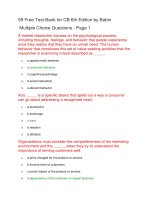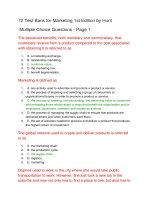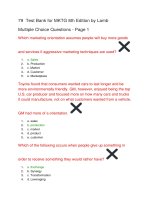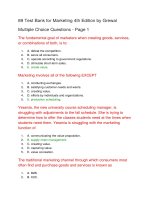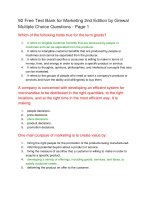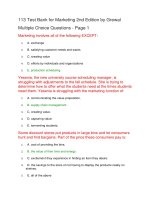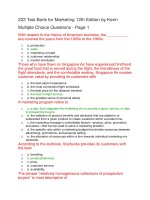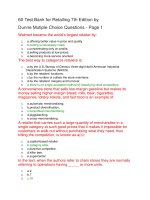Test bank for CJ 4th edition by gaines
Bạn đang xem bản rút gọn của tài liệu. Xem và tải ngay bản đầy đủ của tài liệu tại đây (220.79 KB, 17 trang )
Test Bank for CJ 4th Edition by Gaines
Full
file at />Name:
Class:
Date:
Chapter 01: Criminal Justice Today
True / False
1. The crime control model and the due process model are the two most common models of how society “decides”
which acts are criminal.
a. True
b. False
ANSWER: False
2. The conflict model assumes that a diverse group of people can have similar morals.
a. True
b. False
ANSWER: False
3. Deviance is an objective concept.
a. True
b. False
ANSWER: False
4. All crimes are considered deviant.
a. True
b. False
ANSWER: False
5. Assault and battery are two forms of property crime.
a. True
b. False
ANSWER: False
6. The concept of public order crimes is linked to the conflict model of criminal justice.
a. True
b. False
ANSWER: False
7. The explicit goal of the criminal justice system is to provide justice to all members of society.
a. True
b. False
ANSWER: True
Copyright Cengage Learning. Powered by Cognero.
Full file at />
Page 1
Test Bank for CJ 4th Edition by Gaines
Full
file at />Name:
Class:
Date:
Chapter 01: Criminal Justice Today
8. Federalism is a form of government in which a central government exercises exclusive power in all domestic affairs.
a. True
b. False
ANSWER: False
9. A county sheriff is usually appointed by a chief of police for a term of ten years.
a. True
b. False
ANSWER: False
10. Hawaii has the best state law enforcement agency among all the fifty American states.
a. True
b. False
ANSWER: False
11. The United States has a unified court system.
a. True
b. False
ANSWER: False
12. Those defendants charged with violating state criminal law will always face trial in federal court.
a. True
b. False
ANSWER: False
13. An informal criminal justice system can suffer when individual judgment is tainted by personal bias and plain ill will.
a. True
b. False
ANSWER: True
14. Racial profiling is a crime-fighting tool that allows law enforcement agents to identify a suspect from body fluid
evidence or biological evidence.
a. True
b. False
ANSWER: False
Copyright Cengage Learning. Powered by Cognero.
Full file at />
Page 2
Test Bank for CJ 4th Edition by Gaines
Full
file at />Name:
Class:
Date:
Chapter 01: Criminal Justice Today
15. The underlying value of the due process model is that the most important function of the criminal justice process is to
punish and repress criminal conduct.
a. True
b. False
ANSWER: False
16. The first ten amendments to the U. S. Constitution are collectively known as the code of ethics.
a. True
b. False
ANSWER: False
17. To reduce prison populations, federal and state correctional officials are implementing a number of programs to
increase the recidivism rate of ex-convicts.
a. True
b. False
ANSWER: False
18. One aspect of capital punishment is that a white defendant is much more likely to be sentenced to death for killing a
black victim than a black defendant is for killing a white victim.
a. True
b. False
ANSWER: False
Multiple Choice
19. Which of the following is true of the conflict model of criminal justice?
a. It suggests that public attitudes toward morality are constant and different groups of citizens have similar
opinions on controversial issues.
b. It considers that all groups of society have their interests served by the criminal justice system.
c. It assumes that the most politically powerful segments of society are able to impose their values on the rest of
the community.
d. It argues that the common public has the most influence on criminal laws.
ANSWER: c
20. Which of the following statements is true of deviance?
a. All crimes are considered deviant.
b. Deviance is a subjective concept.
c. Deviance refers to behavior that conforms to social norms.
d. Deviant acts are crimes that are pardoned by society.
ANSWER: b
Copyright Cengage Learning. Powered by Cognero.
Full file at />
Page 3
Test Bank for CJ 4th Edition by Gaines
Full
file at />Name:
Class:
Date:
Chapter 01: Criminal Justice Today
21. Jana is a young, married woman. She gets into a romantic relationship with her colleague, Jacob. She contemplates
divorcing her husband, Mark, and marrying Jacob. But, she does not want to go through the divorce proceedings and
split her assets. She looks for alternatives to part ways with Mark. After much consideration, she decides to get rid of
Mark. One evening, she goes home early after work, sneaks up on her husband, and bludgeons him to death. This
scenario demonstrates _____.
a. burglary
b. assault
c. murder
d. larceny
ANSWER: c
22. A(n) _____ is a threat or an attempt to do violence to another person that causes that person to fear immediate
physical harm.
a. assault
b. battery
c. arson
d. larceny
ANSWER: a
23. Anaida was walking home from work. She was suddenly accosted in an alley by a man wielding a knife. The man
threatened to kill her if she did not hand over all her money to him. Anaida reluctantly gave him the money, and the
man ran away with the money without attacking her. This scenario demonstrates _____.
a. robbery
b. burglary
c. larceny
d. battery
ANSWER: a
24. _____ is the act of taking property from another person without the use of force with the intent of keeping that
property.
a. Robbery
b. Battery
c. Larceny
d. Arson
ANSWER: c
Copyright Cengage Learning. Powered by Cognero.
Full file at />
Page 4
Test Bank for CJ 4th Edition by Gaines
Full
file at />Name:
Class:
Date:
Chapter 01: Criminal Justice Today
25. _____ refers to the unlawful entry of a structure with the intention of committing a serious crime such as theft.
a. Arson
b. Murder
c. Assault
d. Burglary
ANSWER: d
26. Which of the following is true of arson?
a. It is a type of violent crime.
b. It is accidental in nature.
c. It involves the unintentional destruction of a building.
d. It involves the malicious burning of an automobile.
ANSWER: d
27. Which of the following is an example of public order crimes?
a. Gambling
b. Embezzlement
c. Larceny
d. Arson
ANSWER: a
28. Which of the following statements is true of public order crimes?
a. They are a type of organized crime.
b. They are also called victimless crimes.
c. They harm both the offenders and the victims.
d. They are linked to the conflict model of criminal justice.
ANSWER: b
29. Public order crimes are sometimes referred to as victimless crimes because:
a. they often abide by public values.
b. they often harm only the offender.
c. they are linked to the conflict model of crime.
d. they do not give rise to violent crimes.
ANSWER: b
Copyright Cengage Learning. Powered by Cognero.
Full file at />
Page 5
Test Bank for CJ 4th Edition by Gaines
Full
file at />Name:
Class:
Date:
Chapter 01: Criminal Justice Today
30. _____ are nonviolent crimes committed by business entities or individuals to gain a personal or business advantage.
a. Cyber crimes
b. Organized crimes
c. White-collar crimes
d. Public order crimes
ANSWER: c
31. Which of the following is true of white-collar crimes?
a. The most common white-collar crimes include gambling and illicit drug use.
b. White-collar crimes are popularly referred to as victimless crimes.
c. White-collar crimes involve the use of violent means to obtain a business advantage.
d. The extent of white-collar crimes is difficult to determine with any certainty.
ANSWER: d
32. Mark was an employee in a financial services firm. Although he was paid an average salary, he bought a luxury car
with money borrowed from a loan shark. The loan shark threatened to kill him if he did not repay the money within
three months. Intimidated by the threat, Mark embezzled funds from his company. Which of the following crimes did
Mark commit?
a. Public order crime
b. White-collar crime
c. Organized crime
d. Property crime
ANSWER: b
33. Giordana works as a secretary to a criminal lawyer. Her boss often gives her pre-signed blank checks to pay for
miscellaneous expenses. Giordana has a gambling addiction and is part of an underground poker ring run by the mafia.
When she starts losing at poker, she writes down higher numbers on the pre-signed checks and cashes them to pay
her gambling debts. This scenario illustrates that Giordana is involved in _____.
a. a violent crime
b. white-collar crime
c. a property crime
d. high-tech crime
ANSWER: b
34. Which of the following types of crime describes illegal acts carried out by illegal enterprises engaged in the market for
illegal goods or services, such as illicit drugs or firearms?
a. Victimless crime
b. White-collar crime
c. Organized crime
d. Property crime
ANSWER: c
Copyright Cengage Learning. Powered by Cognero.
Full file at />
Page 6
Test Bank for CJ 4th Edition by Gaines
Full
file at />Name:
Class:
Date:
Chapter 01: Criminal Justice Today
35. Which of the following is a traditional preferred market for organized crime?
a. Prostitution
b. Shoplifting
c. Forgery
d. Larceny
ANSWER: a
36. Which of the following statements is true of high-tech crimes?
a. They are popularly referred to as white-collar crimes.
b. They include crimes such as public drunkenness, prostitution, gambling, and illicit drug use.
c. They are directly related to the increased presence of computers in everyday life.
d. They are a traditional form of crime.
ANSWER: c
37. Which of the following is an example of a cyber crime?
a. Selling pornographic materials
b. Running a gambling ring
c. Engaging in loan sharking
d. Smuggling narcotic drugs
ANSWER: a
38. Harvey works as a researcher in a top-secret government laboratory. He discovered a powerful explosive that can be
used as a nuclear weapon. While he was away, Louis, his research partner, hacked into his computer and stole the
chemical formula for the explosive. This scenario illustrates that Louis has committed a(n) _____.
a. violent crime
b. cyber crime
c. property crime
d. organized crime
ANSWER: b
39. The dependence of businesses on computer operations has left corporations vulnerable to:
a. burglary.
b. sabotage.
c. assault.
d. battery.
ANSWER: b
Copyright Cengage Learning. Powered by Cognero.
Full file at />
Page 7
Test Bank for CJ 4th Edition by Gaines
Full
file at />Name:
Class:
Date:
Chapter 01: Criminal Justice Today
40. To safeguard society from criminal behavior, institutions must be created to:
a. approve of capital punishment for all felonies.
b. apprehend alleged wrongdoers.
c. uphold the Fifth Amendment to the Constitution.
d. reinforce self-incrimination.
ANSWER: b
41. _____ is the interlocking network of law enforcement agencies, courts, and corrections institutions designed to
enforce criminal laws and protect society from criminal behavior.
a. The crisis intervention system
b. A neighborhood crime watch
c. The criminal justice system
d. A crime prevention service
ANSWER: c
42. _____ means that all individuals are equal before the law and that they are free from arbitrary arrest or seizure as
defined by the law.
a. Justice
b. Morality
c. Ethics
d. Synergy
ANSWER: a
43. According to Megan Kurlychek of the University at Albany, New York, one of the goals of the criminal justice system
is to:
a. predict the occurrence of crimes in hot-spots.
b. rehabilitate those offenders who have been punished.
c. standardize punishment for all forms of criminal activities.
d. apprehend alleged wrongdoers.
ANSWER: b
44. Which of the following systems of governance was chosen by the framers of the U. S. Constitution?
a. Machiavellianism
b. Federalism
c. Communism
d. Marxism
ANSWER: b
Copyright Cengage Learning. Powered by Cognero.
Full file at />
Page 8
Test Bank for CJ 4th Edition by Gaines
Full
file at />Name:
Class:
Date:
Chapter 01: Criminal Justice Today
45. Which of the following is an express power given to the national government by the Constitution?
a. The power to coin money
b. The power to enact laws to protect the welfare of citizens
c. The power to mandate physician-assisted suicide
d. The power to grant bail
ANSWER: a
46. The ideals of _____ can be clearly seen in the local, state, and national levels of law enforcement.
a. Machiavellianism
b. federalism
c. communism
d. Marxism
ANSWER: b
47. A _____ and its work group are given the weighty responsibility of determining the innocence or guilt of those
suspected of unlawful activities.
a. criminal court
b. rehabilitation center
c. probation department
d. correction facility
ANSWER: a
48. Who among the following is a part of the work group of a criminal court?
a. Wardens
b. Sheriffs
c. Prosecutors
d. Senators
ANSWER: c
49. Which of the following is true of probation?
a. Probation is the least common form of correctional treatment.
b. All offenders are placed on probation regardless of their individual needs and the seriousness of the crimes
committed by them.
c. Probation allows an offender to return to a community and remain under the supervision of an agent of the
court.
d. When probationers adhere to rules of conduct, they are incarcerated.
ANSWER: c
Copyright Cengage Learning. Powered by Cognero.
Full file at />
Page 9
Test Bank for CJ 4th Edition by Gaines
Full
file at />Name:
Class:
Date:
Chapter 01: Criminal Justice Today
50. Unlike jails, prisons:
a. hold criminals on probation.
b. hold those convicted of minor crimes with relatively short sentences.
c. are the domain of federal and state governments.
d. are administered by counties and municipalities.
ANSWER: c
51. Which of the following is an example of a community-based correctional facility?
a. A rehabilitation center
b. A prison
c. A jail
d. A halfway house
ANSWER: d
52. Which of the following is the last step in the criminal justice process?
a. Adjudication
b. Corrections
c. Prosecution and pretrial services
d. Sentencing and sanctions
ANSWER: b
53. Which of the following is a drawback of the formal criminal justice process?
a. It avoids the use of discretion.
b. It is unrealistic in nature.
c. It mandates capital punishment.
d. It dismisses official rules.
ANSWER: b
54. The discretionary decisions made by criminal justice professionals produce a(n) _____.
a. opportunistic criminal justice process
b. formal criminal justice process
c. communalist criminal justice process
d. informal criminal justice process
ANSWER: d
Copyright Cengage Learning. Powered by Cognero.
Full file at />
Page 10
Test Bank for CJ 4th Edition by Gaines
Full
file at />Name:
Class:
Date:
Chapter 01: Criminal Justice Today
55. Which of the following is a judicial discretion in the criminal justice system?
a. Imposing sentences
b. Enforcing laws
c. Investigating specific crimes
d. Detaining people
ANSWER: a
56. Which of the following is most likely a pitfall of discretion in informal decision making?
a. Individual judgement may operate within the rigid confines of formal rules and laws.
b. Individual judgement can be tainted by erroneous thinking.
c. Individual judgement can hinder intuitive thinking.
d. Individual judgement may be substituted with the judgement of the general public.
ANSWER: b
57. _____ is the police practice of improperly targeting members of minority groups based on personal characteristics
such as ethnicity.
a. Ethnocentrism
b. Racial profiling
c. Ethnic penalty
d. Entrapment
ANSWER: b
58. Ideally, actors in the criminal justice system will make moral choices about what is right and wrong based on the:
a. norms established by society.
b. rights guaranteed by the Constitution.
c. laws mandated by the Supreme Court.
d. provisions of the Fifth Amendment.
ANSWER: a
59. Which of the following can be used to address the many ethical challenges inherent in the criminal justice system?
a. The conflict model
b. The consensus model
c. The principle of critical thinking
d. The principle of excluded middle
ANSWER: c
Copyright Cengage Learning. Powered by Cognero.
Full file at />
Page 11
Test Bank for CJ 4th Edition by Gaines
Full
file at />Name:
Class:
Date:
Chapter 01: Criminal Justice Today
60. Unlike Professor Herbert Packer’s crime control model, his due process model:
a. focuses on protecting the rights of the accused through formal, legal restraints on the police, courts, and
corrections.
b. advocates as few restrictions as possible on the ability of law enforcement officers to make discretionary
decisions in apprehending criminals.
c. places primary emphasis on the right of society to be protected from crime and violent criminals.
d. relies on the courts to make it easier to prove the guilt of the accused.
ANSWER: a
61. Homeland security concerns have brought much of the criminal justice system in line with _____.
a. conflict model values
b. consensus model values
c. due process values
d. crime control values
ANSWER: d
62. Decreasing arrest and imprisonment rates suggest that:
a. due process values are strong.
b. crime control values are strong.
c. consensus model values are weak.
d. conflict model values are weak.
ANSWER: a
63. _____ has law enforcement officers focusing on high-crime areas rather than spreading their resources evenly
throughout metropolitan areas.
a. High-tech policing
b. Hot-spot policing
c. Proactive policing
d. Reactive policing
ANSWER: b
64. Which of the following is the most effective new crime-fighting tool?
a. DNA profiling
b. Racial profiling
c. Hot-spot policing
d. Proactive policing
ANSWER: a
Copyright Cengage Learning. Powered by Cognero.
Full file at />
Page 12
Test Bank for CJ 4th Edition by Gaines
Full
file at />Name:
Class:
Date:
Chapter 01: Criminal Justice Today
65. Which of the following amendments to the U.S. Constitution protects the civil liberties of crime suspects and is
relevant to counterterrorism efforts?
a. The Sixth Amendment
b. The Fifth Amendment
c. The Twelfth Amendment
d. The Sixteenth Amendment
ANSWER: a
66. Jake has been subjected to racial profiling by many of the law enforcement officers in his neighborhood. Highly
frustrated by such discriminatory treatment, Jake decides to retaliate. On a Saturday afternoon, he walks into the
precinct with a bomb vest strapped to his chest. He detonates the explosive, killing himself and several police officers.
Using DNA profiling, the police were able to figure out that Jake killed seven police officers. In this scenario, Jake’s
act represents _____.
a. jaywalking
b. false flagging
c. domestic terrorism
d. recidivism
ANSWER: c
67. _____ is the act of committing a new crime after a person has already been punished for a previous crime by being
convicted and sent to jail or prison.
a. Terrorism
b. Recidivism
c. Larceny
d. Anomie
ANSWER: b
68. Which of the following is true of incarceration and race?
a. The number of white men in state and federal prisons is significantly larger than the number of black men.
b. There has been a dramatic increase in the number of Hispanic inmates in federal prisons over the past decade.
c. A white defendant is more likely to be sentenced to death for killing a black victim than a black defendant is for
killing a white victim.
d. As law enforcement agencies have loosened restrictions on immigration laws, the number of Latino inmates
has decreased in state and federal prisons.
ANSWER: b
Copyright Cengage Learning. Powered by Cognero.
Full file at />
Page 13
Test Bank for CJ 4th Edition by Gaines
Full
file at />Name:
Class:
Date:
Chapter 01: Criminal Justice Today
Completion
69. Missouri’s _________ states that a law enforcement agent may use “deadly force” against a suspect if the suspect
is resisting a lawful arrest or “may otherwise endanger life or inflict serious physical injury unless arrested without
delay.”
A. castle doctrine
B. “use of force” law
C. “stand-your-ground” law
D. lethal force doctrine
ANSWER: “use of force” law
70. _________ is behavior that is considered to go against the norms established by society.
A. Conformity
B. Deviance
C. Arraignment
D. Discretion
ANSWER: Deviance
71. _____ are state law enforcement agencies that concern themselves with infractions on freeways.
A. State police
B. State traffic officials
C. State highway patrols
D. State sheriffs
ANSWER: State highway patrols
72. As Nate was running late for work, he hurriedly crossed a neighborhood street outside of a crosswalk. He was
immediately issued a ticket by a traffic cop. This scenario illustrates that Nate committed the crime of _________.
A. arson
B. false flagging
C. jaywalking
D. larceny
ANSWER: jaywalking
Copyright Cengage Learning. Powered by Cognero.
Full file at />
Page 14
Test Bank for CJ 4th Edition by Gaines
Full
file at />Name:
Class:
Date:
Chapter 01: Criminal Justice Today
73. Ethics in criminal justice is closely related to the concept of _________.
A. arraignment
B. anomie
C. deviance
D. justice
ANSWER: justice
74. DNA profiling allows law enforcement agents to _________.
A. predict the possibility of a crime occurrence
B. identify suspects based on their fingerprints
C. identify suspects from body fluid evidence
D. understand the mental state of perpetrators
ANSWER: identify suspects from body fluid evidence
75. _________ refers to the use or threat of violence to achieve political objectives.
A. Discretion
B. Incarceration
C. Recidivism
D. Terrorism
ANSWER: Terrorism
Essay
76. Discuss the consensus model of criminal justice.
ANSWER: The term consensus refers to general agreement among the majority of any particular group. Thus, the
consensus model rests on the assumption that as people gather together to form a society, its members
will naturally come to a basic agreement with regard to shared norms and values. Those individuals whose
actions deviate from the established norms and values are considered to pose a threat to the well-being of
society as a whole and must be sanctioned (punished). The society passes laws to control and prevent
unacceptable behavior, thereby setting the boundaries for acceptable behavior within the group.
The consensus model, to a certain extent, assumes that a diverse group of people can have similar morals.
In other words, they share an ideal of what is “right” and “wrong.” Consequently, as public attitudes
toward morality change, so do laws. In seventeenth-century America, a person found guilty of adultery
(having sexual relations with someone other than one’s spouse) could expect to be publicly whipped,
branded, or even executed. Furthermore, a century ago, one could walk into a pharmacy and purchase
heroin. Today, social attitudes have shifted to consider adultery a personal issue, beyond the reach of the
state, and to consider the sale of heroin a criminal act.
Copyright Cengage Learning. Powered by Cognero.
Full file at />
Page 15
Test Bank for CJ 4th Edition by Gaines
Full
file at />Name:
Class:
Date:
Chapter 01: Criminal Justice Today
77. Discuss the goals of the criminal justice system.
ANSWER: As its name implies, the explicit goal of the criminal justice system is to provide justice to all members of
society. Because justice is a difficult concept to define, this goal can be challenging, if not impossible, to
meet. Broadly stated, justice means that all individuals are equal before the law and that they are free
from arbitrary arrest or seizure as defined by the law. In other words, the idea of justice is linked with the
idea of fairness. Above all, it is desirable that laws and the means by which they are carried out are fair.
Within the broad mandate of “maintaining justice,” Megan Kurlychek of the University at Albany, New
York, has identified four specific goals of the American criminal justice system:
1. To protect society from potential future crimes of the most dangerous or “risky” offenders
2. To determine when an offense has been committed and provide the appropriate punishment for that
offense
3. To rehabilitate those offenders who have been punished so that it is safe to return them to the
community
4. To support crime victims and, to the extent possible, return them to their pre-crime status
78. Explain the concept of federalism in the context of the American criminal justice system.
ANSWER: To understand the structure of the criminal justice system, one must understand the concept of federalism,
which means that government powers are shared by the national (federal) government and the states.
The framers of the U.S. Constitution, fearful of tyranny and a too-powerful central government, chose the
system of federalism as a compromise.
The appeal of federalism was that it established a strong national government capable of handling largescale problems while allowing for state powers and local traditions. The Constitution gave the national
government certain express powers, such as the power to coin money, raise an army, and regulate
interstate commerce. All other powers were left to the states, including police power, which allows the
states to enact whatever laws are necessary to protect the health, morals, safety, and welfare of their
citizens. As the American criminal justice system has evolved, the ideals of federalism have ebbed
somewhat. Specifically, the powers of the national government have expanded significantly. In the early
1900s, only about one hundred specific activities were illegal under federal criminal law. Today, there are
more than 4,500 federal criminal statutes, meaning that Americans are increasingly likely to come in
contact with the federal criminal justice system.
79. Describe the relationship between ethics and justice.
ANSWER: Ideally, actors in the criminal justice system will make moral choices about what is right and wrong based
on the norms that have been established by society. In other words, they will behave ethically.
Ethics in criminal justice is closely related to the concept of justice. Because criminal justice professionals
are representatives of the state, they have the power to determine whether the state is treating its citizens
fairly. If some law enforcement officers in fact make the decision to issue a jaywalking citation on the
basis of the offender’s race, then they are not only acting unethically but also unjustly.
The line between ethics and justice is often difficult to discern, as ethical standards are usually not written
into criminal statutes. Consequently, individuals must often “fill in” the ethical blanks.
Copyright Cengage Learning. Powered by Cognero.
Full file at />
Page 16
Test Bank for CJ 4th Edition by Gaines
Full
file at />Name:
Class:
Date:
Chapter 01: Criminal Justice Today
80. Distinguish between Professor Herbert Packer’s crime control model and due process model.
ANSWER: In describing the general direction of the criminal justice system as a whole, many observers point to two
models introduced by Professor Herbert Packer: the crime control model and the due process model. The
underlying value of the crime control model is that the most important function of the criminal justice
process is to punish and repress criminal conduct. The system must be quick and efficient, placing as few
restrictions as possible on the ability of law enforcement officers to make discretionary decisions in
apprehending criminals.
Although not in direct conflict with crime control, the underlying values of the due process model focus
more on protecting the rights of the accused through formal, legal restraints on the police, courts, and
corrections. That is, the due process model relies on the courts to make it more difficult to prove guilt. It
rests on the belief that it is more desirable for society that ninety-nine guilty suspects go free than that a
single innocent person be condemned.
Copyright Cengage Learning. Powered by Cognero.
Full file at />
Page 17
